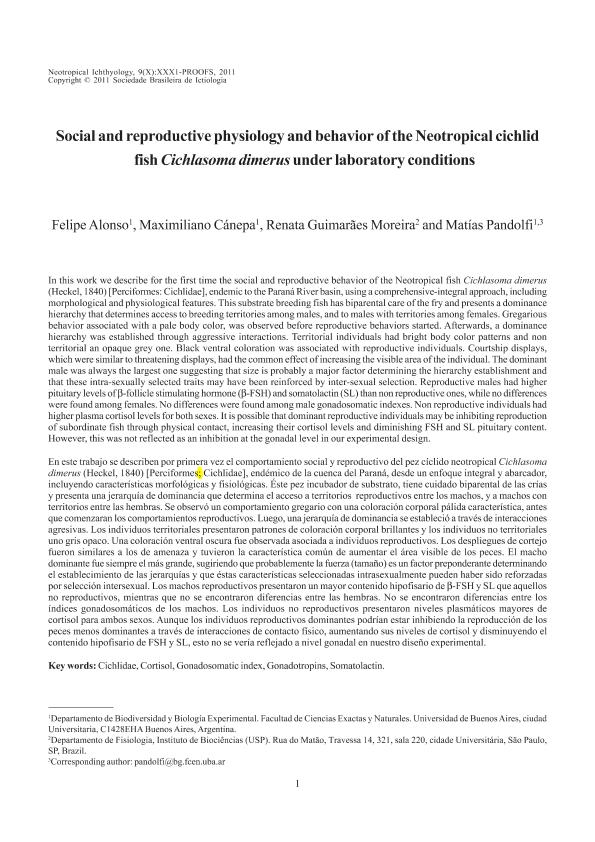Mostrar el registro sencillo del ítem
dc.contributor.author
Alonso, Felipe

dc.contributor.author
Canepa, Maximiliano Martin

dc.contributor.author
Moreira, Renata Guimarães
dc.contributor.author
Pandolfi, Matias

dc.date.available
2019-01-17T17:55:08Z
dc.date.issued
2011-09
dc.identifier.citation
Alonso, Felipe; Canepa, Maximiliano Martin; Moreira, Renata Guimarães; Pandolfi, Matias; Social and reproductive physiology and behavior of the Neotropical cichlid fish Cichlasoma dimerus under laboratory conditions; Sociedade Brasileira de Ictiologia; Neotropical Ichthyology; 9; 3; 9-2011; 559-570
dc.identifier.issn
1679-6225
dc.identifier.uri
http://hdl.handle.net/11336/68195
dc.description.abstract
In this work we describe for the first time the social and reproductive behavior of the Neotropical fish Cichlasoma dimerus (Heckel, 1840) [Perciformes: Cichlidae], endemic to the Paraná River basin, using a comprehensive-integral approach, including morphological and physiological features. This substrate breeding fish has biparental care of the fry and presents a dominance hierarchy that determines access to breeding territories among males, and to males with territories among females. Gregarious behavior associated with a pale body color, was observed before reproductive behaviors started. Afterwards, a dominance hierarchy was established through aggressive interactions. Territorial individuals had bright body color patterns and non territorial an opaque grey one. Black ventral coloration was associated with reproductive individuals. Courtship displays, which were similar to threatening displays, had the common effect of increasing the visible area of the individual. The dominant male was always the largest one suggesting that size is probably a major factor determining the hierarchy establishment and that these intra-sexually selected traits may have been reinforced by inter-sexual selection. Reproductive males had higher pituitary levels of β-follicle stimulating hormone (β-FSH) and somatolactin (SL) than non reproductive ones, while no differences were found among females. No differences were found among male gonadosomatic indexes. Non reproductive individuals had higher plasma cortisol levels for both sexes. It is possible that dominant reproductive individuals may be inhibiting reproduction of subordinate fish through physical contact, increasing their cortisol levels and diminishing FSH and SL pituitary content. However, this was not reflected as an inhibition at the gonadal level in our experimental design.
dc.format
application/pdf
dc.language.iso
eng
dc.publisher
Sociedade Brasileira de Ictiologia

dc.rights
info:eu-repo/semantics/openAccess
dc.rights.uri
https://creativecommons.org/licenses/by-nc-sa/2.5/ar/
dc.subject
Cichlidae
dc.subject
Cortisol
dc.subject
Gonadosomatic Index
dc.subject
Gonadotropins
dc.subject
Somatolactin
dc.subject.classification
Otras Ciencias Biológicas

dc.subject.classification
Ciencias Biológicas

dc.subject.classification
CIENCIAS NATURALES Y EXACTAS

dc.title
Social and reproductive physiology and behavior of the Neotropical cichlid fish Cichlasoma dimerus under laboratory conditions
dc.type
info:eu-repo/semantics/article
dc.type
info:ar-repo/semantics/artículo
dc.type
info:eu-repo/semantics/publishedVersion
dc.date.updated
2019-01-14T18:03:40Z
dc.identifier.eissn
1982-0224
dc.journal.volume
9
dc.journal.number
3
dc.journal.pagination
559-570
dc.journal.pais
Brasil

dc.journal.ciudad
Porto Alegre
dc.description.fil
Fil: Alonso, Felipe. Consejo Nacional de Investigaciones Científicas y Técnicas. Oficina de Coordinación Administrativa Ciudad Universitaria; Argentina. Universidad de Buenos Aires. Facultad de Ciencias Exactas y Naturales. Departamento de Biodiversidad y Biología Experimental; Argentina
dc.description.fil
Fil: Canepa, Maximiliano Martin. Universidad de Buenos Aires. Facultad de Ciencias Exactas y Naturales. Departamento de Biodiversidad y Biología Experimental; Argentina. Consejo Nacional de Investigaciones Científicas y Técnicas. Oficina de Coordinación Administrativa Ciudad Universitaria; Argentina
dc.description.fil
Fil: Moreira, Renata Guimarães. Universidade de Sao Paulo. Departamento de Fisiología. Instituto de Biociencias; Brasil
dc.description.fil
Fil: Pandolfi, Matias. Universidad de Buenos Aires. Facultad de Ciencias Exactas y Naturales. Departamento de Biodiversidad y Biología Experimental; Argentina. Consejo Nacional de Investigaciones Científicas y Técnicas. Oficina de Coordinación Administrativa Ciudad Universitaria; Argentina
dc.journal.title
Neotropical Ichthyology

dc.relation.alternativeid
info:eu-repo/semantics/altIdentifier/url/http://ref.scielo.org/r43nxs
dc.relation.alternativeid
info:eu-repo/semantics/altIdentifier/doi/http://dx.doi.org/10.1590/S1679-62252011005000025
Archivos asociados
